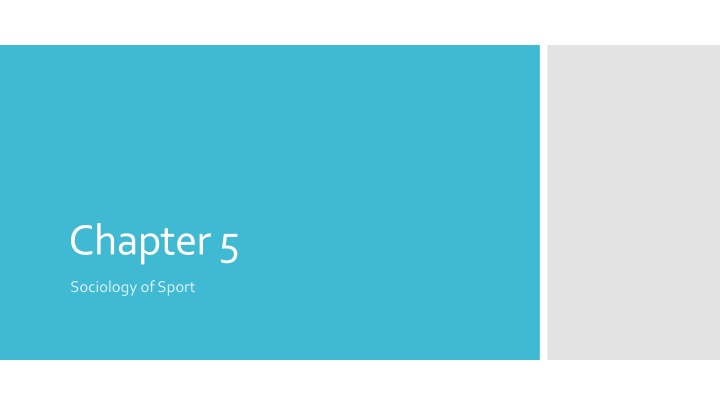
Sociology of Sport: Research, Academic Reforms, and Community Relations
Explore the sociology of sport through topics like research challenges, academic reforms in NCAA, and the impact of sports on school-community relations. Discover insights on ethnicity, leadership, and academic detachment in sports at various educational levels.
Download Presentation

Please find below an Image/Link to download the presentation.
The content on the website is provided AS IS for your information and personal use only. It may not be sold, licensed, or shared on other websites without obtaining consent from the author. If you encounter any issues during the download, it is possible that the publisher has removed the file from their server.
You are allowed to download the files provided on this website for personal or commercial use, subject to the condition that they are used lawfully. All files are the property of their respective owners.
The content on the website is provided AS IS for your information and personal use only. It may not be sold, licensed, or shared on other websites without obtaining consent from the author.
E N D
Presentation Transcript
Chapter 5 Sociology of Sport
5.1. Research faculty are not eager to study intercollegiate sports 5.2. A brief history of NCAA academic reforms High School & College Sports 5.3. School community relations 5.4. Ethnicity and sports participation among high school girls 5.5. Conformity or leadership in high school sports 5.6. Academic detachment among college athletes
Four factors inhibit critical research on college sports. These factors are located in the university, the community, traditional academic disciplines, and the NCAA. University Constraints Discipline Constraints Community Constraints NCAA Constraints Research faculty are not eager to study intercollegiate sports Athletic department administrators and coaches feel that faculty do not understand what and how they teach and cannot do research that would assist them in meeting the expectations that dominate their lives.
NCAA Reform Timeline: 1983-NCAA passes Proposition 48 setting, 1986-Proposition 48 takes effect. 1990-U.S. Congress passes a law requiring all colleges to make public their athlete graduation rates starting 1991-USA Today and major media companies publish data on athlete graduation rates 1991-The Knight Foundation Commission on Intercollegiate Athletics publishes its report, "A New Model for Intercollegiate Athletics." 1993-NCAA boosts Proposition 48 initial-eligibility requirements to a 2.5 (not 2.0) high school GPA in 13 (not 11) core courses and a minimum score of 68 (not 60) on the new ACT scale, or 820 (not 700) on the new SAT scale. 1994-Passage of the Equity in Athletics Disclosure Act requiring all institutions of higher education that receive certain forms of federal 1996-New initial-eligibility requirements take effect. All high school students wishing to play sports at Division I or II schools must register and be certified by an NCAA Initial-Eligibility Clearinghouse. A brief history of NCAA academic reforms
School community relations Interscholastic sports programs do two things in the realm of school-community relations: they attract attention, and they provide entertainment. It is easy to see that sports can connect schools to communities, but we do not know if these connections benefit academic programs or the achievement of educational goals.
Increases in Varsity Sports Participation, US Sophomore Girls by Ethnicity, 1989-90 to 2001-02. Source: Based on data collected by the U.S. Department of Education and analyzed by Sylwester (2005). Ethnicity and sports participation among high school girls ETHNIC GROUP 1989-90 2001-02 Percentage INCREASE over 12 Years Participation Rate Participation Rate White 44% 56% 27% Hispanic (any race) 29% 36% 24% Black 38% 47% 24% Native American 38% 40% 5% Asian 36% 36% 0%
Too many high school programs are organized to emphasize obedience rather than responsibility. Why should adult coaches make all the decisions on student sports teams? How does that build responsibility? Conformity or leadership in high school sports Ideally, the goal of every coach should be to prepare his or her team to be self-coached at some point during the season. What would happen if coaches had to allow players to coach themselves for the last two games of the season? Having such a requirement would force coaches to build real leadership among players.
After five years of observing, interviewing, traveling with, and hanging out with athletes and coaches for a big-time college basketball team, the Adlers concluded that playing on such a team and being seriously involved in academic courses seldom go hand in hand. Academic detachment among college athletes The men discovered that selecting easier courses and majors was necessary if they were to meet coaches expectations. Fatigue, the pressures of games, and over forty hours a week devoted to basketball kept them from focusing seriously on academic tasks. Academic detachment was supported in the team culture. These young men were with one another constantly in the dorms, at meals, during practices, on trips to games, in the weight room, and on nights when there were no games.
